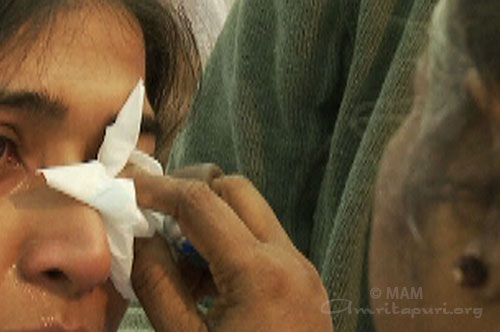Last week during darshan, I remained at Amma’s side for some time. It wasn’t long before a middle-aged woman came for darshan. She was from central Kerala. It was her first time meeting Amma. She told Amma that early this year her husband had been fishing around 3:00 a.m., casting his net from the boat, when he suddenly had a stroke and fell into the mud of the shallow waters. In tears, she explained that he had become stuck in the mud and drowned. She said she didn’t know what to do. Their eldest child, who was in his mid-twenties now, was permanently brain-damaged from a shock he had received from a faulty electrical outlet when he was only three. Because she had to do everything for him, from putting on his pants to brushing his teeth, she told Amma that it was impossible for her to work. She said that sometimes he could become violent, flying into a rage for no perceivable reason. Earlier she could handle it, but the older and stronger he became, without her husband around, the more unmanageable it was becoming. Her family’s sole income comes from her youngest son, who repairs car stereos. Amma dried her tears and called a devotee from her area and asked him to try to arrange some financial and infrastructural support for her and her family.
Not long after that, a long-time devotee from Northern Kerala came for darshan. Her husband had been one of the first people to invite Amma to their hometown. He passed long back, killed in a political clash. Since then, their family’s income has been limited. Still the mother had managed to get their daughter enrolled in a nursing school, and the girl had just graduated. The problem is that now the girl either has to pay an Rs. 150,000 bond to her school or work for its hospital at 33 percent beneath the standard starting wage for three years—Rs. 8,000 a month, instead of Rs. 12,000. Her other child is autistic. She says that he can chant the Lalita Sahasranama flawlessly—that he even corrects her when she makes pronunciation mistakes. But, despite being 29, he cannot be left unsupervised for even a minute. On this day, the mother had come to ask Amma’s guidance for what to do with her daughter.
Soon after, a middle-aged man came up to Amma. You could tell by his puffy skin and the yellowish tint to his eyes that he was suffering from hepatitis. He told Amma that it was his second flare-up since contracting the disease seven years ago. He said he used to work in retail sales, but that now, with his liver 70-percent destroyed, he can no longer maintain a job. He had had to get a tube inserted to drain out the water from his abdomen. Now his legs get swollen. His doctor told him recently that he is in dire need of a liver transplant within the next three months. Married with a son and a sick mother to look after, he had come to ask if he would be able to get some help from Amma for the liver transplant at Amrita Hospital. Amma entrusted an ashramite to look into the still-smiling man’s case and do the needful.

Amma has often said that we should listen to the life stories and woes of at least 10 people who have come for Amma’s darshan. In that way, Amma says, we will be able to develop compassion. Just hearing these three stories, I felt a bit overwhelmed. How much suffering is there in this world? How many such burdens have people laid at Amma’s feet? I remember someone once asked Amma why sannyasa is considered a harder path than that of a gruhasta (householder), and Amma responded that while a gruhasta is only responsible for one family, the Sannyasi is ultimately responsible for the entire world. I am not sure if all Sannyasis see it this way, but Amma in her total renunciation has taken up the struggles of countless individuals, countless families. Even if you don’t consider the charitable assistance the ashram provides for people like this, Amma has dedicated her entire life to being there for such people—being a shoulder to cry on, an ear that is always ready to listen, a smile to take inspiration from….
28 Aug 2014
~ Dhyanamrita